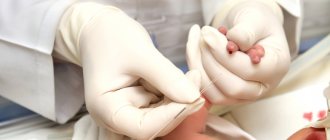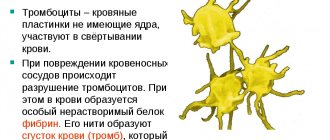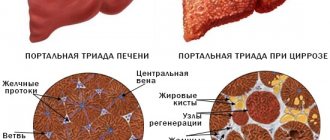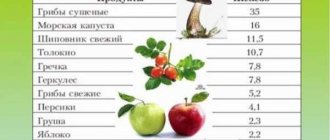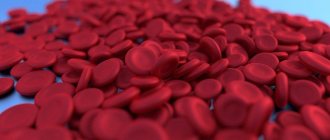Indicators of normal hemoglobin in the blood of women
The norm depends on age. The table shows the average normal values [1]:
| Under 18 years old | 110-140 g/l |
| 18-39 years old | 120-150 g/l |
| After 40 years | 117-148 g/l |
| Pregnant women | 105 g/l and above |
As can be seen from the table, in order to understand how low a woman’s hemoglobin is, you first need to know her age. After all, in every period of life, physiological (regular menstruation, pregnancy) or pathological processes (presence of chronic diseases) occur that will affect blood counts.
Symptoms of low hemoglobin in women
To determine the first symptoms, you first need to understand what hemoglobin is, its functions, as evidenced by its decrease in a woman’s body.
The normal functioning of the cells of our body depends on the constant supply of oxygen to them. This is the main function of blood - the transport of oxygen, which comes from the external environment, from the lungs to the cells, and the removal of carbon dioxide from the body.
This vital function of oxygen transport depends on hemoglobin. This is a protein found in red blood cells - erythrocytes. There are about 280 million hemoglobin molecules in 1 ml of blood.
Since the function of hemoglobin is to deliver oxygen to cells, its deficiency is associated with oxygen starvation of tissues. Accordingly, the load on the respiratory system and heart increases. They will try to compensate for the effects of low hemoglobin by increasing their breathing rate and heart rate. The nervous system also suffers from oxygen starvation. You may notice paleness of the skin, since the presence of a sufficient amount of hemoglobin and red blood cells gives the skin a healthy flesh tone.
Symptoms of low hemoglobin in women:
- Fatigue, lethargy, decreased performance, deterioration of exercise tolerance - the body tries to save energy in order to supply oxygen to vital organs, reducing blood flow to the muscles.
- Shortness of breath - increased breathing to compensate for oxygen deprivation of tissues.
- Increased heart rate - the heart also tries to increase blood flow to tissues, thus increasing oxygen levels.
- Migraine, dizziness, deterioration of intellectual abilities are signs of oxygen starvation of the brain.
- The pallor of the skin depends on the degree of decrease in hemoglobin; if it is insignificant, then the skin may be of a normal flesh tone, but the mucous membranes of the eyes, mouth, and nose appear pale.
- A decrease in blood pressure is a dangerous symptom that is a sign of blood loss.
The severity of symptoms depends on the time during which hemoglobin decreased. If it drops sharply within a few days, the symptoms will be pronounced and cause severe discomfort to the woman. If its level decreased gradually over several months, even if it dropped significantly, then the body had enough time to adapt to the lack of oxygen, in which case the symptoms will be less pronounced.
Why does it decrease to 113 g/l
A woman's hemoglobin level of 113 or below indicates anemia, but not the cause of the disease. To select the correct course of treatment, it is necessary to determine additional parameters of red blood cells: their number, hematocrit, MCV and MCH.
There are many forms of anemia, which are based on different causes:
- iron deficiency;
- vitamin B-12 deficiency;
- folic acid deficiency;
- bleeding;
- a type of cancer that affects the bone marrow, such as leukemia;
- renal failure;
- liver disease;
- hypothyroidism,
- thalassemia, a genetic disorder that causes low levels of hemoglobin and red blood cells.
Why does hemoglobin drop in women: finding the reason
A decrease in the level of hemoglobin and red blood cells in the blood is called anemia. What does low hemoglobin mean in women? The causes of this condition can be divided into several groups:
- deficiency of vitamins, microelements: iron, vitamin B12, folic acid;
- acute blood loss, for example, during surgery;
- disturbances in the formation of red blood cells (erythropoiesis), increased destruction (hemolysis);
- chronic blood loss: heavy menstruation (more than 300 ml per cycle), gastrointestinal bleeding;
- oncological diseases, condition after chemotherapy;
- the presence of chronic inflammatory diseases: rheumatism, Crohn's disease;
- pregnancy.
Next, we will take a closer look at the most common causes of low hemoglobin in women.
Iron deficiency in the blood
Iron is a trace element that is necessary for the formation of hemoglobin. It is so important for normal blood formation that the body even contains iron depots: these are organs that store iron and are ready to provide it if it does not come from outside. These include bone marrow, liver, and spleen. The normal level of iron in the blood for women is 11-25 µmol/l.
Also, a protein circulates in the blood plasma - ferritin, which contains iron molecules. When serum iron levels decrease, the required number of iron atoms are separated from ferritin to restore its level in the blood. The ferritin norm for women is 30-300 ng/ml, with an average of 49 ng/ml.
That is, if a blood test shows a decrease in serum iron, this means that all depots have already been emptied. There is no iron, therefore, no hemoglobin either: anemia has developed. And if the iron level is normal, but ferritin is reduced, then you need to understand: there is little ferritin due to a lack of iron in the blood serum, it has nothing to bind, it is destroyed due to its uselessness. These are the first signs of the development of anemia. They are also called latent, that is, hidden. There are no visible symptoms yet, but they will appear soon.
In addition, another indicator is important. This is a transferrin protein, whose function is to bind serum iron and transport it for the formation of young red blood cells. If iron is deficient, the body will produce more transferrin to search for and bind iron. An important indicator is the ratio of free iron to bound transferrin. Normally, 20-50% of transferrin is bound by iron; with anemia, this figure decreases.
Development of anemia
There are the following degrees of anemia:
| Degree of anemia | Hemoglobin |
| I (light) | 109-101 g/l |
| II (moderate) | 100-71 g/l |
| III (severe) | <70 g/l |
A hemoglobin level of 50 g/L or below is classified as very severe anemia. She is in critical condition.
The development of the clinical picture of anemia is not always associated only with the degree of decrease in hemoglobin levels. This depends on the woman’s body’s ability to adapt to oxygen starvation.
It is worth noting additional symptoms that are distinctive for this type of anemia. In addition to shortness of breath, tachycardia, dizziness, fatigue, the following also appear:
- Dry skin, decreased elasticity, and appearance of an earthy tint. Cheilitis occurs - inflammation of the red border of the lips with the appearance of dryness and cracks.
- Hair becomes dull, splits, and begins to fall out more.
- Nails become dull, thin, and flattened.
- Perverted taste preferences arise: women often eat chalk or ice. They also notice that they begin to like strong chemical smells, such as paint or kerosene.
Iron deficiency anemia is most common among women. But there are also other types of anemia.
Erythropoiesis disorders
A decrease in the amount of hemoglobin may also be associated with defects in the maturation of young red blood cells (dyserythropoiesis).
In such cases, we are talking about B12-folate deficiency anemia. It can occur through a deficiency of vitamin B12, folic acid (vitamin B9). But most often they come in pairs, since they have the same reasons for the occurrence and changes in blood tests.
Nowadays, a lack of vitamins B9 and B12 from food is almost never encountered. Therefore, the cause of B12-folate deficiency anemia is a violation of the absorption of vitamins: diseases of the gastrointestinal tract (enteritis or enteropathy, conditions after removal of part of the stomach or intestines, cancer). This kind of anemia can occur during pregnancy and breastfeeding due to the increased consumption of vitamins by the woman’s body.

Vitamins B9 and B12 are involved in the formation of DNA in blood cells. Therefore, with their deficiency, erythropoiesis will slow down and occur with defects. Red blood cells will be larger in size, have a shorter lifespan, and have a lower ability to transport hemoglobin.
What is dangerous about vitamin B12 deficiency: with its deficiency, metabolic processes in the nervous system and mucous membranes of the gastrointestinal tract will be disrupted, and symptoms characteristic only of this anemia will occur:
- the appearance of mental disorders (delusions, hallucinations);
- unsteady gait;
- disturbances in the sensitivity of the limbs (paresthesia), pain, numbness, feeling of weakness in the legs;
- the appearance of stomatitis;
- inflammation of the mucous membrane of the stomach, small and large intestines (gastroenterocolitis);
- inflammation of the tongue followed by smoothing of its papillae (the so-called lacquered tongue, or Gunther's glossitis).
B12-folate deficiency anemia is a complex blood disease with a detailed clinical picture and a complete change in the blood picture. If you have the above symptoms, you should contact your family doctor.
Increased destruction of red blood cells
Another group of anemia, which has a fundamental difference from the rest. In this case, the formation of red blood cells and hemoglobin is not impaired. But for some reason the body destroys them. This phenomenon is called hemolysis.
Hemolytic anemia most often has an acute onset and severe symptoms. They usually occur after the action of some factor that provokes the destruction of red blood cells:
- transfusion of blood incompatible by group or Rh factor;
- the effect of poisons (lead salts, arsenic, hydrogen sulfide, nitrates, snake venom);
- viral infections;
- mechanical destruction of red blood cells (for example, damage to an artificial heart valve).
In addition to pronounced general symptoms, during hemolysis, breakdown products of red blood cells and hemoglobin will accumulate, which the liver actively utilizes. Therefore, the skin acquires a yellow tint, which distinguishes this type of anemia from others.
Drop in hemoglobin during menstruation
The female body, due to its physiological structure, is capable of self-healing. Every month, a woman of reproductive age loses blood during her period. If you take a blood test before and after menstruation, you can see a drop in hemoglobin levels before and its normalization after menstruation.
But in the case of long or heavy menstruation, in the case of short cycles, the body has to restore this blood loss too often. Because of this, iron depots in the body may be depleted, which will lead to iron deficiency anemia, especially in women over 30 years of age.
If your menstrual duration is more than ten days, or blood loss is more than 300 ml (15 pads per 4-5 drops per cycle), or the cycle duration is less than 21 days, it is worth monitoring the level of hemoglobin and ferritin in the blood.
After surgery or chemotherapy
After surgery, the body needs time to recover. Including to compensate for blood loss. Mostly this happens on its own. And if a woman has suffered a large loss of blood during the operation, doctors perform a transfusion of blood or its individual elements.
After chemotherapy, you should also expect your blood cell levels to drop below normal. Chemotherapy does not specifically affect only malignant tumors; it destroys all cells in the body that are capable of rapid regeneration and division. These are skin cells, mucous membranes, blood elements, tumor cells. Therefore, after chemotherapy, in addition to cancer treatment, a woman also experiences anemia, decreased immunity, hair loss and other side effects.
Pregnancy and low hemoglobin
A pregnant woman's circulating blood volume increases by 50%. This happens in order to, in addition to its own body, supply the fetus with blood and deliver nutrients to it.
Due to the fact that the increase in blood volume occurs by increasing the amount of its liquid part - plasma, there is a relative decrease in blood cells and hemoglobin per 1 ml of blood. But if a woman had low hemoglobin before pregnancy, then during pregnancy a lack of iron or vitamins will provoke an even greater decrease in it and the occurrence of anemia.
In case of iron deficiency anemia in pregnant women, it is necessary to monitor the attending physician and replenish the amount of iron in the blood and depositing organs. If this is not done, after childbirth the condition will only worsen: during childbirth, the female body suffers blood loss, the body will have nothing with which to replenish it.
Age-related changes in the body
As women age, their metabolism begins to slow down and their hormonal levels begin to change. The body ends its reproductive period and menopause occurs. During this period, women are also susceptible to developing anemia.
Drop in hemoglobin in women after 40
The period of a woman’s life after 40 is premenopause. Estrogen levels begin to drop and periods become irregular. It is at this age that the likelihood of dyshormonal uterine bleeding increases.
Since hormonal levels are unstable and menstruation is irregular, a woman may perceive the onset of bleeding as menstruation. Such chronic bleeding can lead to the development of anemia. Also, estrogen hormone therapy to treat menopausal symptoms may reduce iron absorption. Therefore, women over 40 years old should regularly visit their gynecologist.
Decrease in hemoglobin levels in women after 50
Women over 50 also have a risk of developing anemia. For some, premenopause or menopause will occur at this age. But most often the cause at this age is chronic diseases. Gastritis, peptic ulcer, enteritis, colitis are accompanied by a decrease in the absorption of nutrients in full. This, as a result, will lead to the development of iron deficiency or B12-folate deficiency anemia.
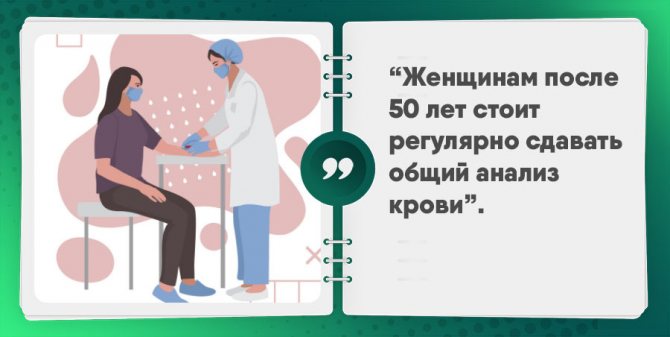
Low hemoglobin in women after 60
Age after 60 is dangerous for the development of cancer. In 60% of cases when malignant tumors are diagnosed, the patient is over 60 years old. Anemia in the case of oncology can develop as a result of chronic bleeding, and can also be aggravated by the presence of chronic diseases and poor absorption of nutrients.
It is worth regularly examining the entire body in older women once a year for timely diagnosis and successful treatment of oncology.
Your red blood cells are rapidly being destroyed
In some pathological conditions, blood cells die faster than new ones appear.
Enlarged spleen
Normally, this organ should destroy old and damaged cells. But if the spleen is enlarged, it can destroy good red blood cells. This condition is called splenomegaly Enlarged spleen (splenomegaly). Symptoms include anemia, feeling tired and frequent bleeding.
What to do
After the examination, the doctor may recommend removing the spleen.
Porphyria
It is an inherited disease of Porphyria. In humans, hemoglobin synthesis is disrupted due to a lack of special enzymes. A toxic substance, porphyrin, accumulates in the blood, which can destroy red blood cells. Anemia occurs and the following symptoms appear:
- pain in the abdomen, chest, legs;
- red or brown urine;
- constipation or diarrhea;
- convulsions;
- urinary disturbance;
- increased blood pressure;
- mental disorders, hallucinations;
- blisters, redness and itching of the skin;
- burning pain when the body is exposed to sunlight.
What to do
Treatment for Porphyria depends on the symptoms. Most likely, you will have to follow a diet for the rest of your life, not smoke, give up alcohol, and protect your skin from the sun. The doctor may also prescribe hormones and medications that will help reduce the synthesis of dangerous porphyrin in the body.
Hemolysis
In this condition, red blood cells are intensively destroyed by Hemolysis. Hemolysis develops due to infections, autoimmune diseases or the action of toxins. A person suddenly or gradually develops Hemolytic Anemia. In some cases it is so severe that it leads to death.
What to do
It all depends on the person’s condition and the cause of hemolysis. Sometimes iron or folic acid supplements are sufficient for treatment. Some patients need drugs to suppress the immune system, and others need blood transfusions.
Thalassemia
This is a rare hereditary disease Thalassemia blood, in which a DNA mutation develops. It leads to the appearance of hemoglobin with an abnormal structure, which causes red blood cells to be destroyed. With this disease, the spleen enlarges, iron accumulates in the body, heart problems and bone deformities occur.
What to do
Typically, the disease is diagnosed as Thalassemia in childhood, which is why a hematologist prescribes treatment early. This could be a blood transfusion, taking special medications to remove excess iron, or even a bone marrow transplant.
Sickle cell anemia
This is the name of the hereditary disease Sickle cell anemia, in which red blood cells are shaped like a sickle or crescent. Therefore, they get stuck in the vessels, are quickly destroyed, and the person becomes anemic. This disease is accompanied by severe muscle pain, swelling, frequent infections and an increased risk of stroke.
What to do
Treatment usually begins in childhood, as signs of the disease appear early. A hematologist prescribes Sickle cell anemia medications that help slow down the destruction of red blood cells and reduce the symptoms of anemia. Sometimes a blood transfusion or stem cell transplant is required.
Consequences of low hemoglobin in women
With anemia, the entire body suffers from a lack of oxygen. At the same time, the load on the heart and lungs increases: they need to work more actively to deliver the required amount of oxygen to organs and tissues. Due to prolonged oxygen starvation, all organs will suffer. Consequences of low hemoglobin in women:
- Heart failure. Constant long-term stress on the heart muscle leads to its exhaustion and stretching. In this condition, the heart rate will increase even more due to the cardiovascular system's attempts to normalize the level of oxygen in the blood. Cardiosclerosis and chronic heart failure with heart rhythm disturbances develop.
- Respiratory failure. In cases of heart failure, there is an increased load on the respiratory system. Due to the fact that the heart cannot normally deliver blood to the tissues, the body increases the breathing rate, trying to compensate for oxygen deprivation. With such an increased load, over time, normal lung tissue is replaced by scar tissue. Respiratory failure develops.
- Brain dysfunction. Oxygen starvation of the brain also has its consequences. The body will ensure sufficient blood flow to vital centers: breathing and cardiac activity. At the same time, other functions are disrupted. A woman with anemia feels tired, lethargic, unable to work, and will suffer from dizziness and headaches.
- Kidney and liver failure. The liver and kidneys are organs that are responsible for removing toxins from the body. With increased work of the heart and lungs, the number of chemical compounds that need to be removed from the body increases. Therefore, the state of chronic cardiac and respiratory failure will eventually be joined by the phenomena of renal and liver failure. Especially when using a large number of medications.
- Decreased immunity. In a state of oxygen starvation, the body has no reserves to fight viral or bacterial infections. If a woman with anemia gets a common cold, the recovery process will always be longer.
And low is not good and high is bad
Does increased hemoglobin occur during menopause in women? Yes. What is the reason for this:
- Decreased blood plasma volume. This is observed with diarrhea, vomiting, high temperature, and limited drinking regimen.
- Diseases that cause chronic oxygen deficiency in the body. These are heart failure, emphysema, bronchial asthma.
- The development of erythremia - a tumor blood disease, accompanied by a sharp increase in red blood counts.
Why is an increase in hemoglobin in the blood during menopause bad? Imagine trying to put on a dress that is a size too small for you. A red blood cell loaded with hemoglobin feels approximately the same when trying to pass through the capillaries of the microvasculature. Considering that the capillaries are no longer young, and atherosclerotic plaques are like mushrooms after rain, then good things cannot be expected. Increasing blood viscosity can lead to the development of stroke, thromboembolism, and myocardial infarction.
Doctor Anastasia Khomyakova
How to increase hemoglobin in the blood of women?
What to do? First you need to determine the cause of its decrease, then treat it. If it is iron deficiency anemia and the hemoglobin level is above 100 g/l, it can mostly be treated with an iron-containing diet. If very low hemoglobin is detected in a woman, treatment should be prescribed by a hematologist.
Seeking qualified help
If you suffer from increased fatigue, lethargy, decreased performance, deterioration of intellectual capabilities, dizziness, shortness of breath, palpitations, you should suspect the presence of anemia. In this case, you should contact a specialist and undergo the necessary tests.
What is the hemoglobin test called?
A general clinical blood test, which must be taken annually, and for pregnant women every trimester, will help determine a decrease in hemoglobin levels. This test can determine the level of red blood cells (RBC) and hemoglobin (Hb), white blood cells (WBC) and leukocyte formula, as well as the erythrocyte sedimentation rate. Some laboratories immediately determine the color indicator (the amount of hemoglobin in each red blood cell); if this is not the case, your doctor can determine this. This indicator helps the doctor in determining the type of anemia.
Sometimes it is necessary to take a biochemical blood test for serum iron, transferrin, ferritin, cyanocobalamin (vitamin B12), folic acid (vitamin B9), and determine the level of direct and indirect bilirubin. These tests will help the doctor make a differential diagnosis and determine the type of anemia.
Which doctor should I contact if I have low hemoglobin?
If symptoms of anemia appear, you should contact your family physician. The doctor will collect an anamnesis of the disease and conduct an examination to determine a preliminary diagnosis, because the general symptoms of anemia are characteristic of many other diseases. The doctor will write you a referral for a general clinical and, if necessary, biochemical blood test.
In cases of mild to moderate anemia, treatment is prescribed by your family doctor. And if symptoms appear suddenly within a few days, or severe anemia, then treatment is prescribed by a hematologist in an inpatient setting. In some cases, drug therapy may be needed. In any case, the doctor must decide how to increase hemoglobin.
Drugs to increase hemoglobin
In order to increase hemoglobin, you first need to cure the cause of its decrease. If a woman has a deficiency of iron or vitamins, it needs to be replenished; if anemia occurs as a result of chronic bleeding, the cause of the bleeding must be treated along with correcting the hemoglobin level.
Iron supplements for low hemoglobin
It would seem that the body does not have enough of a microelement - which means you need to use more food containing it or medications. But what plays a role here is not just what a woman eats when her hemoglobin is low, or what medications are used to increase it. Iron can undergo chemical reactions in the stomach or intestines. These reactions can increase its absorption or prevent it. Therefore, we have outlined for you the basic rules for taking iron supplements.
- The daily iron requirement for women of reproductive age is 15 mg. The average amount of iron taken with food is 50-100 mg, of which only 10-25 mg (20-25%) is normally absorbed. If you take iron medications, the level of its absorption will be the same: per 100 mg, only 20 mg will be absorbed. But you should not increase the prescribed dosage to speed up recovery from anemia. Iron that is not absorbed (80 mg of the 100 mg taken) can irritate the intestinal mucosa. And if you increase the dose, it will be worse absorbed, more irritate the mucous membrane of the digestive tract, cause constipation and abdominal pain.
- Mild iron deficiency anemia in non-pregnant women is most often corrected with diet. A small deficiency can be compensated for by eating a large amount of foods that contain iron. In this case, drug therapy will cause more harm, irritate the intestines and will not lead to rapid restoration of hemoglobin.
- If hemoglobin decreases below 70 g/l, treatment takes place in a hospital setting with intravenous administration of drugs. The dose is prescribed individually, iron deficiency is replenished quickly enough.
- The duration of treatment with tablets is 4-8 weeks to increase hemoglobin by 20 g/l. If the dynamics are weaker, you should consult a doctor to prescribe intravenous administration of iron-containing medications.
- To increase iron absorption, it is also worth increasing the level of vitamin C, B12 and folic acid.
- When taking iron supplements, it is important to take it with water or orange juice (vitamin C) for better absorption. Do not drink milk, tea or coffee - they impair the absorption of iron.
- Iron is a chemical element that can have different valencies. Bivalent iron preparations have a better degree of absorption than trivalent iron. But the choice is always up to your attending physician: he prescribes the drug taking into account your hemoglobin level, age, cause of anemia and the presence of concomitant diseases.
There are many iron preparations on the pharmaceutical market, which differ in valency (divalent or trivalent) and type of salt (organic or inorganic).
Ferrous iron is better absorbed in the intestines, so it is often used to treat iron deficiency anemia. The main drugs: totema (iron gluconate), ferretab (iron fumarate) - representatives of organic salts; sorbifer, actiferrin, tardiferon, ferro-gradumet (iron sulfate), hemofer (iron chloride) - inorganic salts.
Advantages of ferric iron preparations: high digestibility, treatment duration is shorter than with ferric iron.
Disadvantage: higher incidence of side effects.
The best ferrous iron preparations
- Actiferrin is ferrous sulfate produced in Germany. Available in the form of capsules, drops, syrup - choose the one that is convenient for you. It has a pleasant currant taste. The composition includes the amino acid L-serine, which increases the absorption of iron. With a combined deficiency of iron, vitamin B12, and folic acid, it is possible to use the combined drug Aktiferrin compositum, which contains all these substances in one capsule.
- Totema is an iron gluconate produced in France. Available in the form of a solution in ampoules for oral administration. The ampoule can be poured into apple or orange juice for better absorption and taste. Contains manganese and copper - they increase the bioavailability of iron.
When treated with ferric iron preparations, the risk of developing side effects such as bloating, a feeling of heaviness in the abdomen, nausea, and constipation is reduced. Main preparations: ferlatum (iron succinylate) – organic salt; ferrum-lek, maltofer, biofer – inorganic salt of iron hydroxide with polymaltose.
Advantages: less frequency and severity of side effects, available in injection ampoules for the treatment of severe anemia.
Disadvantages: the degree of digestibility is lower than that of divalent ones, long-term treatment.

